|
|
|
Michael Lambert- Pushing Rivers, Saving WaterAmigos de la Presa: Solve the Water Crisis and Have Fun While You're at It
|
|
|
Whoever said, "You can't push a river" never met Michael Lambert. Michael has been advocating for water, very successfully, for decades; first for 18 years in Pittsburgh as founder and head of Three Rivers Rowing Association (1,000 daily rowers, $5 million+ assets) and president of Friends of the Riverfront, where he was at the heart of Pittsburgh's renaissance ("Best US Retirement City" AARP 2012) and since 2006 here in San Miguel de Allende as chief of Amigos de la Presa. His rowing program has been the model for many other cities.
Michael, even while he was meeting with the elites of major corporations to plan revitalization from the top down, has always advocated a community approach. He builds constituencies in the most natural way possible, by putting communities in touch with the resources that need saving. You might call it "grassroots", but since it's on the water, with paddle and oar, I think "stroke by stroke" is better terminology. He makes "stakeholders", or makes people aware that we are all already stakeholders.
I interviewed Michael during San Miguel Days, occupying Cafe Contento's back room to do so. His beard is graying, but other than that he seems ageless. Our talk, punctuated by the rhythms of drums, was suspended in favor of the parade passing the front door. His enthusiasm for the dancers and their costumes was childlike and infectious. His easy going persona is the perfect complement to the seriousness of his mission, to save water and us along with it. He is as natural as the resources for which he advocates.
Following the interview is a short explanation of the water crisis. Please read it. Then, do yourself a favor, do us all a favor, go meet Michael and many other wonderful people, volunteer to help through Amigos de la Presa or one of its sister organizations.
- Dr Dave (Fialkoff)
|
| |
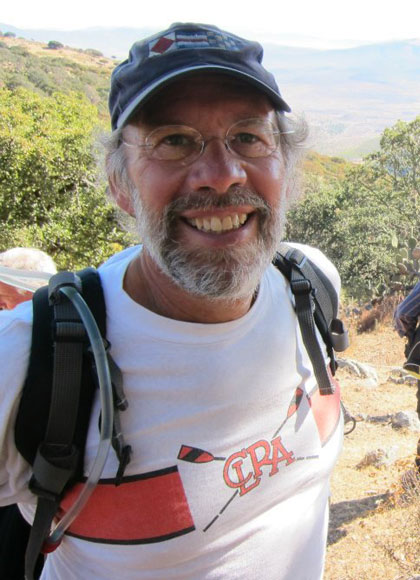 |
|
Please note: much of this very informal conversation has been condensed and paraphrased. Space and time considerations do not allow us to display Michael's full eloquence. There were so many interesting points brought up that some were necessarily abbreviated. Any awkwardness is the editor's.
|
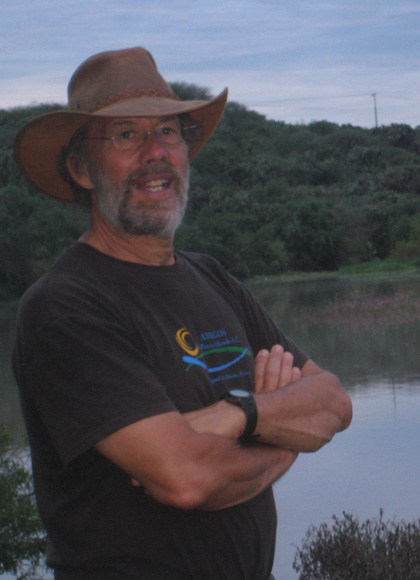 |
|
I left New Hampshire to go to graduate school in Pittsburgh. I stayed, practicing psychotherapy and also employed as the Program Director for Catholic Charities and a bunch of other advocacy positions. I was running with the director of the YMCA and told him that I had been rowing up in New Hampshire at Dartmouth and he suggested we should have rowing here at Pittsburgh and that’s how it all started.
Coming from the pristine waters of New England I was astonished that the water in Pittsburgh could be so abused by people; it was not even appealing to put a boat into the water.
However, when the steel mills began closing in the early 80s there was some beginnings of the natural process of reclamation the rivers; flowing bodies of water, if you just stop polluting them being to make improvement on their own, unassisted. In 1984 while there was still all kinds of junk in the water we bought a couple used 4-person shells. In the early days we stored them in a warehouse still being used for tanning sheep hides; it smelled; over in the corner was a big pile of sheep tails, pretty disgusting.
Two miles upstream from where the Allegheny and Monongahela join to form the Ohio, really in downtown Pittsburg, is Herr's Island. It was slated for redevelopment, but because of its history as a slaughterhouse and stockyard, no one wanted it. We suggested that if they gave us some land we'd bring rowing to the island and perhaps stimulate further development. They agreed and there we rented the back of a trailer truck and stored the boats in there. Then Carnegie Melon University brought another trailer in and a couple of high schools also, and before we knew it we had 6 or 7 trailers lined up side by side; it looked like a trucking depot.
We did turn things around; that island has since won many national and international accolades for its green development.
|
On Google Earth, you can see our beautiful boathouses, including the Lambert Boathouse. Attached to it we built another boathouse and then we built a third across the channel; 3 boathouses, over 15000 square feet- $1 million for the first, 1.5 million for the second, 2.8 for the third, not counting any of the inside stuff, boats, etc.- used by three universities, around 20 high schools, corporate rowing programs, competitive men and women, programs for kids, inner-city kids, physically challenged, visually impaired, on and on. We have over 1000 people using the facility on a daily basis. It's truly a community place.
|
|
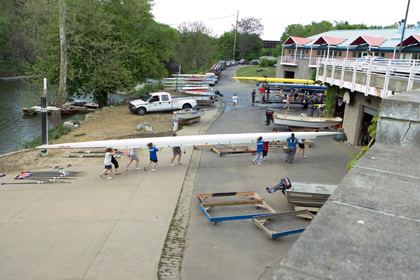 |
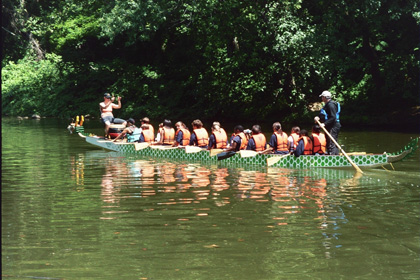 |
|
Rowing 6 inches above the water you can't help but have a keen awareness of it. Those using the boathouse experience an environmental consciousness raising. People seeing these elegant shells slipping by also draws attention to the rivers. That happens here on the Presa. People say, "You're on that water? Is it safe?"
We became involved in a whole array of environmental efforts related to the river, from picking garbage up and out onto homemade barges to committees of the highest level corporate executives who recognized the rivers as central to the redeveloped, the reinvention of Pittsburgh. I was president of Friends of the Riverfront which developed 60 miles of trails in the urban environmental, one of which goes all the way to Washington, DC. Pittsburgh is now, according to AARP Magazine one of the top places to retire in the US. The lead story was of a woman who rows every morning within walking distance of her home. It's very gratifying.
|
Our experience has been repeated in cities around the country. Ours was the first that involved all segments of the community, breaking the stereotype of rowing being an elitist sport.
We want to use the same basic idea of using recreation here to bring people to the water. We have kayaking, sailing, rowing, maybe even windsurfing someday, hiking, biking and bird-watching, all in the vicinity of the Rio Laja and Presa. In addition to these wonderful activities we invite people to lend a few hours a month to environmental initiatives that we do through Amigos de la Presa. On one hand we receive enjoyment and on the other hand we give back making it a nicer place for everyone.
|
|
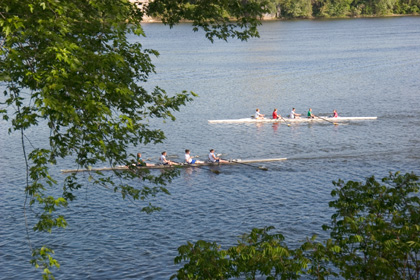 |
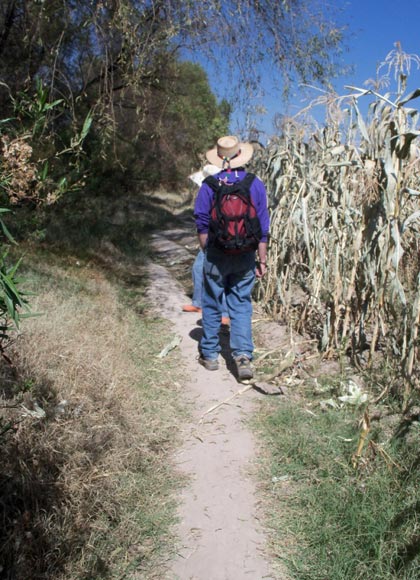 Trail along Rio Laja Trail along Rio Laja |
|
All the studies point to a water crisis here in San Miguel de Allende and in the region. The aquifer is emptying. Wells often aren't regulated. Water is showing levels of minerals that are toxic to people and agriculture, levels that are increasing.
My group, Amigos de la Presa has joined with Audubon and Salvemos al Rio Laja, creating Agua Vida SMA. We've have 3 initiatives: to build a hiking/biking/equestrian trail all around the Presa and up the Rio Laja to Dolores Hidalgo; a citizens water quality testing project all alongof wells and of the Rio Laja and in the Presa Allende; and a year-long residential water conservation campaign here in SMA.
Around here the ground is so hard-packed that whenever it rains water doesn't have a chance to absorb into the earth to help to replenish the aquifer for the future. It just runs very fast and tears off the top soil. Much of the most fertile land gets washed away filling the Presa with silt to the point where its losing must of its volume.
Salvemos al Rio Laja, headed by Agustin Madrigal, has projects to slow the water. They go into communities all around San Miguel de Allende along hillsides and such to create stone damns, like steps, to slow water as it comes down. On the downstream side they plant trees to help hold the earth. They do many projects involving entire communities, encouraging the land to regenerate. They pay the community for every meter of work they do. They're getting paid, but they're also getting educated. Before the Spanish invasion all these hillsides were covered with forest.
|
The goal of the water conservation campaign is not only to save water in the urban area, but to build stakeholders in the process, to build awareness, to build involvement. Our theory is that if you actually start doing small things to save water in your own household, then you will take an interest in the water situation here. You become a stakeholder. You would at that point be a person that says "you know I believe it's important." You would probably even tell someone else a couple of the things you do to save water in your household because you think it's kind of cool, and maybe they start to do it, too. If we build some of that stakeholder investment then we can effectively confront the huge water abusers that exists in some of the agricultural practices in the region. We know approximately 85% of the water that is used in this region is used by agriculture. It is well documented that over 50% of water waste is in agriculture. That's our water, water for the common good.
|
|
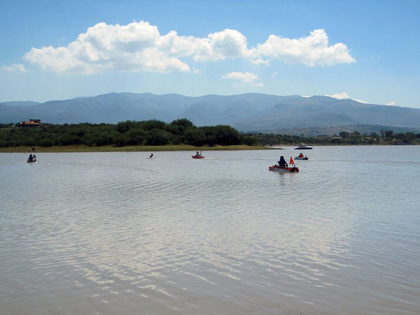 Boats on the Presa Boats on the Presa |
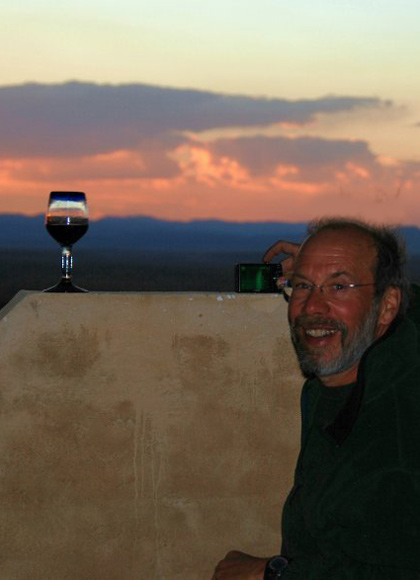
| |
Those who attempt to have environmental laws and regulations enforced, usually have to approach these things from an adversarial point of view. I have seen that there are also other ways, that you can approach these things through recreation; it's a softer, but nevertheless successful approach. You start building a constituency that will support various measures.
A book by Charles Fishman called The Big Thirst traces how in the 19th century and even into the 20th, there were still a lot of people who didn't have water from taps. Maybe they had water from pumps and public fountains, but not at home. During the 20th century most people became very accustomed to the idea that water is endless. You can wash your car and do all these sophisticated industrial commercial things and it just goes on and on. Fishman's point is that has come to an end. Now we must realize that water is not infinite. We realize that there is a defined amount of water on earth. We've got to change attitudes. We've got to change the culture around water.
***
|
|
Mexico is at the same latitude as the world's major deserts. 70% of the territory (central and northern) has an arid or semi-arid climate, while 30% has a humid climate - where surface water is abundant.
Paradoxically, urban and industrial centers are concentrated in the center and the north of the country where water is most scarce. This is possible thanks to the presence of groundwater. 75 million Mexicans and more than 40% of agriculture depend on groundwater.
Water has been poorly managed based on erroneous assumptions. There is not a unified comprehensive water management plan. Lack of understanding and poor management has critical consequences in terms of various social, economic, political, and environmental aspects.
Groundwater moves through and is stored in enormous geological formations called aquifers. This water is found starting a few meters below the surface under natural conditions, and up to hundreds of meters in depth when extracted excessively.
Groundwater has an age, based on when it first entered the aquifer. The "young" water of recent years has been depleted and the "fossil" water that is now being extracted entered the aquifer around 5,000-35,000 years ago. The groundwater of this region is no longer a renewable resource on a human scale. That is, these aquifers do not recharge or renew year after year
Groundwater can be contaminated by the improper disposal of urban, agricultural or industrial waste and also, as in the deeper levels of the aquifer, which are now being tapped, when it moves for a very long time through deep channels in rock formations that contain minerals that in high concentration are toxic to humans, such as arsenic, a carcinogen, and fluoride. (In Guanajuato state there are 8,000 cases of dental fluorosis, which destroys the hardest bone in the human body, the gums of young children.) Such mineral are also toxic to plants. Excess sodium affects the fertility of the soil, photosynthesis and the movement of nutrients in the plant. In severe cases the soil becomes totally unproductive; approximately 15% of agricultural soils have already been affected. Recent studies show that levels of fluoride, arsenic and sodium in this region and its surroundings, including the state of Queretaro, is increasing in a continuous and significant manner.
The groundwater situation in the Lerma-Chapala Basin (Mexico, Queretaro, Guanajuato, Michoacan, Jalisco) and in particular in the state of Guanajuato is critical. The excessive extraction of groundwater has produced an environmental disaster which threatens the sustainability of development and progress of all sectors in the state. This "mining" of groundwater results in the decline of the aquifers by 2 - 10 meters per year. Shallow areas of the aquifer are being left without water and, for many other parts it is only matter of time; all this has a negative impact in food production and employment. Pseudo-science has resulted in an irrational extraction of groundwater; authorizing those who extract the most water to extract even more, at the expense of neighboring zones
We are in a critical state with regard to the aquifers due to the fact that decisions are made prioritizing large water infrastructure projects (particularly those financed by the World Bank and the Inter-American Development Bank) - expensive projects that incur public debt without necessarily meeting current and actual needs. On the other hand, these policies promote the uncontrolled growth of cities and urban needs, which, sooner or later, will have to be reduced.
"In the 2nd World Water Forum, held in The Hague in March 2000, it was stated that water is merchandise... more to the point, certain governments have paved the way for private companies to sell water, for profit, to the thirsty citizens of the world. And so a handful of multinational enterprises, backed by the World Bank and International Monetary Fund are now trying to control the management of water-related public services, dramatically increasing the price that local residents pay for water, especially taking advantage of desperate Third World efforts to find a solution to the water crisis."(p15)
" Some of these companies have no qualms confessing their motives; they boast that the reduction of freshwater reserves and changes in guidelines for its use have created an extraordinary business opportunity for water companies and their investors. Their philosophy is clear: water should be treated as any other tradable product and its use and distribution determined by principles of economic benefit." (p15)
"At the same time, some governments relinquish control over national water reserves in order to sign trade agreements such as the North American Free Trade (NAFTA); its successor project, the Free Trade Agreement of the Americas (FTAA); and the World Trade Organization (WTO). Indeed, these global trade institutions provide, in a way until now unimaginable, access for multinational companies to the fresh water reserves of signatory countries... As yet, most such initiatives have been carried out without public consultation or support. The powerful governmental forces and the business sector both start from the assumption that this debate is already a done deal: [the entire world] accepts the commercialization of water." (p15-16)
"... the nations of the world declare that the earth's fresh water reserves are a common global good, to be protected and cared for by all peoples, communities and governments at all levels, and also it is proclaimed that fresh water should not be privatized, marketed, sold or exported for commercial purposes, but from this point forward must be excluded from all current and future international and bilateral trade agreements, as well as investment agreements." (p20)
Maude Barlow y Tony Clarke, (2004). Oro Azul, Las multinacionales y el robo organizado en el mundo, Editorial Piados, Mexico, 416p.
Excerpted and paraphrase from: Groundwater in Mexico: A Scientific and Legislative Perspective, published in the Punto de Acuerdo Magazine, Fundación Humanismo Político A.C.,
February 2011 by Dr. Marcos Adrian Ortega Guerrero, Fulltime Researcher at the Center for Geosciences, Juriquilla Campus, Queretaro, National Autonomous University of Mexico (UNAM).
|
|
|
|
|
|
|